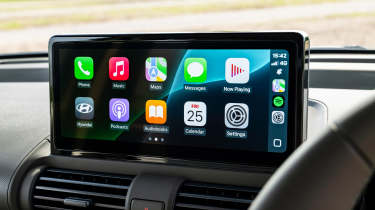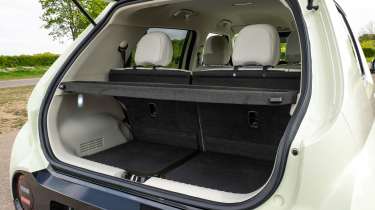Much like with the paint, the Inster’s standard black interior is very dull and doesn’t really suit this car’s personality, which is why we recommend opting for the beige and khaki brown colour scheme that’s a no-cost option with 02 trim, with houndstooth seat upholstery like you can get in a Porsche 911 – that’s probably the only thing those two cars have in common, though.
Materials and build quality
There are next to no soft-touch materials throughout the cabin, which is disappointing as rivals like the Renault 5 manage to pepper in some fabrics or other materials in places. At least the overall build quality is solid, and we couldn’t hear any rattling or squeaking from the plastic trim in our test car.

Sat-nav, stereo and infotainment
Apple CarPlay and Android Auto are standard, as is the 10.25-inch touchscreen mounted on top of the dashboard, which we wish had been positioned lower to make it easier to reach.
The Inster doesn’t feature Hyundai’s very latest software, instead it uses an infotainment system that’s actually two generations old. Sure, it doesn’t look quite as slick or modern as the stuff in the brand’s newer models, but the benefit of using older software is that Hyundai has ironed out all the kinks and bugs. It also gets the job done, and the graphics are clear; however, there are numerous menus to navigate through, and they can be quite laggy.
The sliding rear bench gives the Inster an edge over key rivals, however it only comes with higher-spec models

| Pros | Cons |
|
|
Hyundai has squeezed every possible millimetre of cabin space out of the Inster, managing to create a 3.8-metre-long city car with the Tardis-like quality of allowing six-foot adults to comfortably sit in the back of it. There are only four seats, however, and cabin storage is neither here nor there, with spaces on the dashboard and in the centre console to store odds and ends, but the door bins are only large enough for a wallet.
Dimensions and size
Measuring 3,825mm long, 1,610mm wide and 1,575mm tall, the Hyundai Inster is a little bit longer than the Dacia Spring, but shorter than its more direct rivals such as the Citroen e-C3, Renault 5 and Fiat Grande Panda.
| Dimensions | |
| Length | 3,825mm |
| Width | 1,610mm |
| Height | 1,575mm |
| Number of seats | 4 |
| Boot space | 238-351 litres |
Driving position, seats & space in the front
There’s plenty of adjustability in the steering wheel and captain’s chair to find a comfortable seating position. In between the front seats, which at a glance look like they’re one big bench, are a pair of cup-holders and a rather tiny armrest. Headroom is superb, and the view out is great, thanks to the tall body and large glasshouse.


